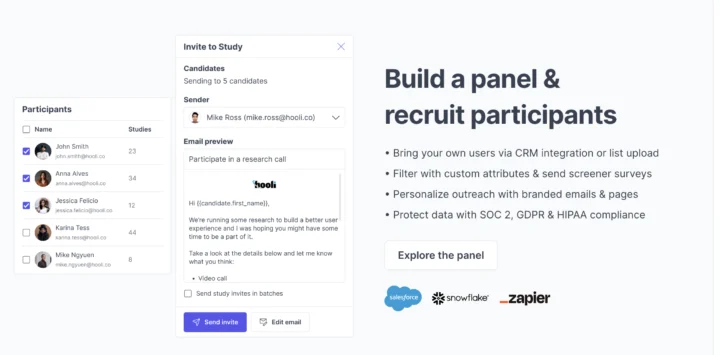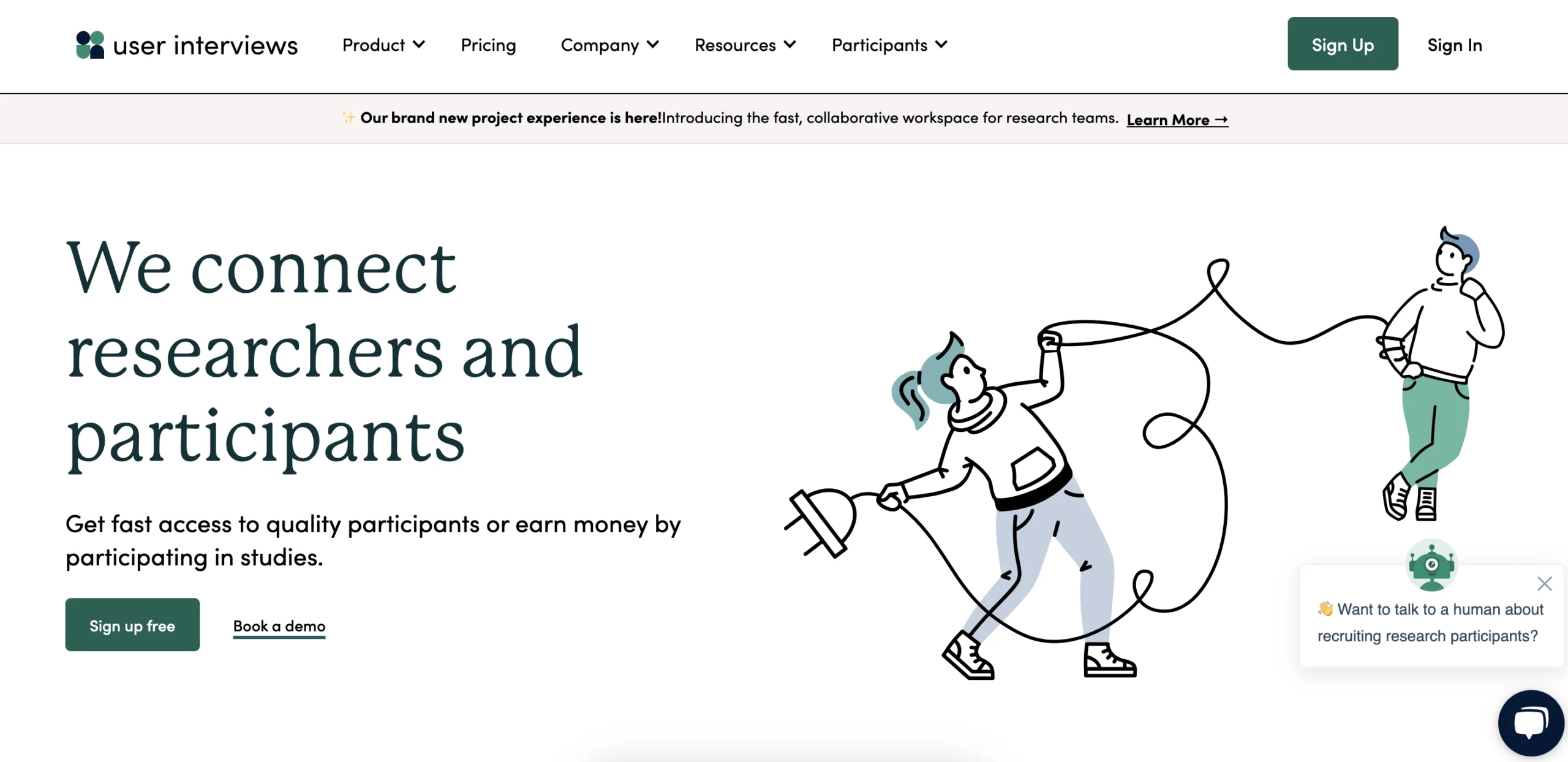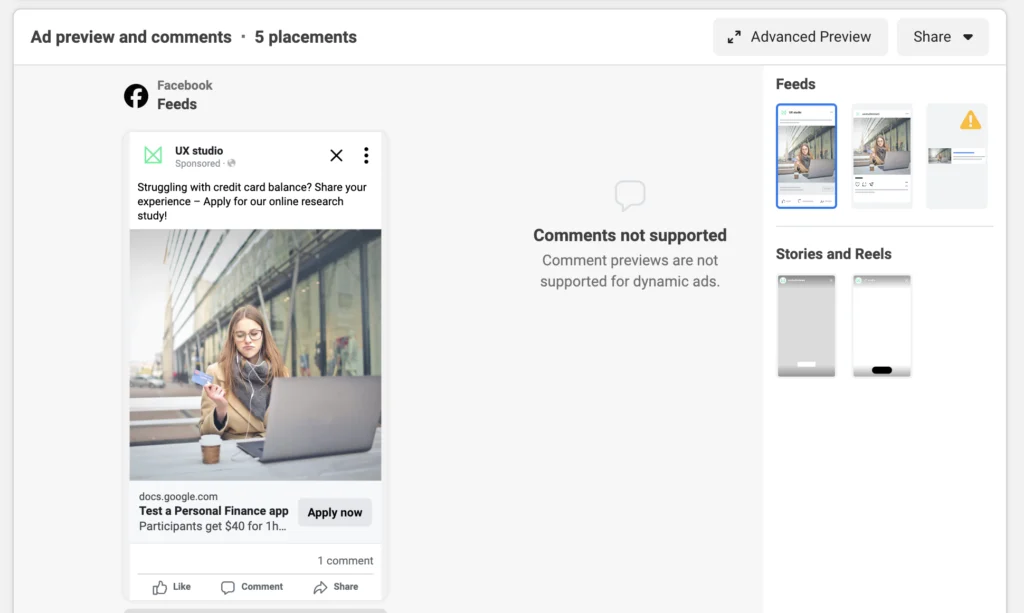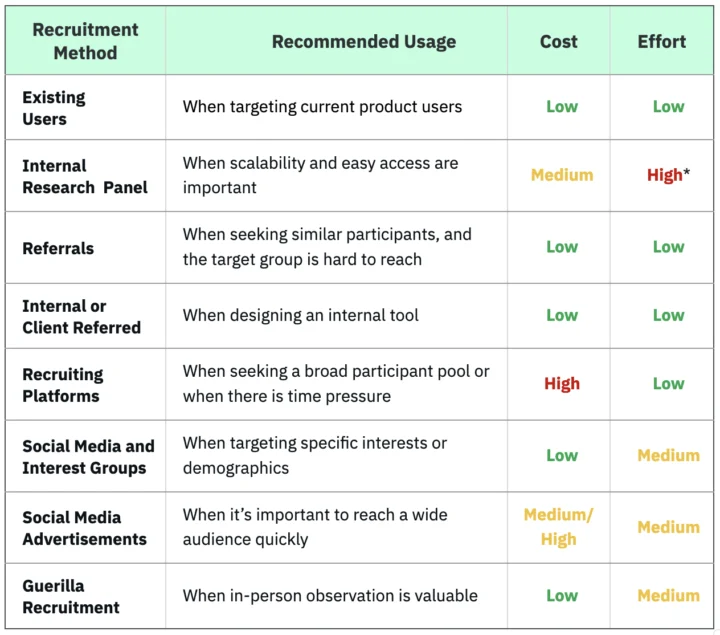Contents
Participant recruitment is crucial for successful UX research. That's why we want to help by guiding you through 8 common ways to find suitable participants. By understanding the pros and cons of each, you will be able to select the best recruitment method for your research study.
Recruitment in UX research is finding participants for your qualitative research activity. It is crucial for obtaining valuable data and ensuring the overall success of the research process. By carefully selecting participants who represent the target audience, researchers can gather meaningful insights into that specific user group’s behaviors, needs, and pain points.

Often, this is easier said than done. Recruiting participants who represent the target group can be challenging. This is especially true with specific and hard-to-reach populations. Effective recruitment also requires careful screening and selection. This can take significant time and effort.
But don’t worry, we are here to help you. In this article, we’ll explore 8 common ways how to recruit participants for research, sharing the key advantages and disadvantages based on our professional experience.
Let’s jump right in.
1. Ask your existing users to participate.
You would generally use this type of recruitment when you need participants with experience with the product or service the research focuses on. It’s usually effective when the company has an easy way to reach users – like a mailing list or newsletter.
Advantages
Recruiting existing users is quick and easy. The company often has a lot of valuable information about its customers that can help with selection and screening.
Disadvantages
When you try to reach a new target audience, recruiting existing users won’t provide accurate results. This is because your insights will be limited to the current user base. Also, it can be challenging to recruit participants if the company doesn’t have effective ways to reach customers or if the business hasn’t been around for a long time.
Finally, you might face sampling and confirmation bias. Your participants already have a relationship with the company and brand. This could influence their answers.
2. Build your own internal research panel.
This is quite like inviting your existing users, but it makes the process more scalable. The difference is that you create a dedicated pool of volunteers willing to take part in future research activities. To do this, you will need to recruit participants using other approaches, like those mentioned in this article.
Building a panel ensures that you always have a group of people to choose from when testing new features or collecting insights about previous experiences with the product.
This approach works best for companies building their own products but can also be utilized by agencies like UX Studio. Having a research panel allows you to invite participants from the pool when their characteristics align with the target audience. You can also use it when the topic of study is broad and doesn’t need strict criteria.
Building and maintaining a research panel in a business-to-business (B2B) setting can be beneficial. Accessing and involving actual users can be challenging when developing a product or service for businesses. Building a panel of B2B users creates a valuable resource. This provides direct access to your target audience.
Furthermore, having a panel can make it easier for businesses to start and conduct research. The effort involved in recruiting participants is reduced. You have an established pool of willing participants. This can encourage companies to incorporate research more into their processes. Doing so leads to better-informed decisions and improving the user experience.

Advantages
One of the key advantages is that the people who accept to be part of your panel are usually motivated to take part in research studies. You can gather extensive information about them. This allows for filtering based on specific needs in future recruitment. Additionally, maintaining a panel enables better control over participant quality. This includes factors like communication style.
Disadvantages
Building and managing a user panel requires time and dedicated administrative tasks. Neglecting the panel for an extended period can result in losing contact with recruited users. This makes it increasingly difficult to reach them. Yet, this issue may be less relevant in B2B settings.
Panel management tools also come with extra costs. But, managing the panel by yourself requires extra effort and resources. If you decide to build your own research panel, carefully consider and adhere to data privacy rules. This ensures compliance with regulations like the General Data Protection Regulation (GDPR).
Additionally, monitoring the size and diversity of your panel is crucial to avoid over-reliance on a small group of people. This is crucial, as it can lead to biased feedback and limit the effectiveness of your research efforts.
3. Ask for referrals from current users or previous participants.
In academic research, this is often referred to as the snowball method. People use this type of recruitment when the target group is hard to reach with other approaches, but you know someone who can contact the group. It can also be valuable when you’ve already recruited a good fit for the study and need help in recruiting similar participants. You could also use this technique when you don’t have specific research criteria.
Advantages and disadvantages
It is a quick, low-effort, and cost-effective approach. Yet, it’s important to note that this method may result in losing control over the sample and recruitment process. We don’t recommend using it if you have very rigorous research criteria. It’s also not advised to use it when it’s essential to have a representative sample.
4.Talk to people who work inside the company or industry.
You would use this type of recruitment when the team is designing an internal tool for the employees of a company. In the case of agencies, this can also mean that the client refers participants from that specific industry.
It can also be a suitable approach when a rigorous non-disclosure agreement protects the product so the company doesn’t want outsiders to see it.
Advantages and disadvantages
Internal recruitment is quite low-effort, cost-effective, and time-efficient. Yet, the data collected may not provide reliable insights. It is true if the internal employees or client-referred participants do not represent the target group. Moreover, you should consider the potential biases arising from the participants’ affiliation or professional relationship with the company.
5. Subscribe to a recruiting platform.
Subscribing to a recruiting platform is a convenient option for finding research participants. Several online tools can help quickly identify suitable participants. This approach is particularly beneficial for research topics that have broad target audiences.

Advantages
Recruiting platforms generally offer a large pool of interested participants. People who book a research session are usually willing to show up. This results in fewer no-shows than most other recruitment methods. They often provide automated scheduling and built-in screeners, streamlining the recruitment process. Additionally, the platform takes care of data handling in compliance with GDPR rules.
Disadvantages
Subscription prices can change from platform to platform. Yet, automated recruiting tools are generally more costly than other recruitment methods. Also, if you have a very niche target group, you might not be able to find participants with these tools.
There are also more and more “professional testers” on these websites. These people use these research opportunities as their primary source of income. Because of this, they have significant experience with UX and testing. This influences the quality and authenticity of the insights. Additionally, some people may provide false information on the screener. To avoid this, you must be extra careful with selection and screening.
Things to consider
According to our experience, there can be significant differences among the recruitment tools. When choosing a recruiting platform, you should consider some important things. These include price, pool size and composition, screening options, and refund policies. If you want to use an online recruitment tool, we recommend exploring the different options. This way, you can make sure you choose the one that best suits your needs.
6. Post in social media and online interest groups.
Recruiting through social media, online forums, and interest groups can be effective. It is a way to find participants with specific interests, experiences, or backgrounds. Here’s an overview of some of the most popular platforms and their considerations:
Posting research invitations on Facebook works well for general, popular research topics. It attracts many interested people. It is a cost-effective alternative to recruiting platforms and helps avoid professional testers.
Yet, it can be time-consuming. Joining different Facebook groups and getting your post approved is often tricky. Response rates may be low for less popular research topics. Also, there can be several unreliable applicants and no-shows.
For targeting professionals in specific industries, try LinkedIn. It allows you to find highly qualified people who would be difficult to reach elsewhere. Another advantage is that you will already have lots of background information about them since you can access their LinkedIn profiles.
Yet, the free version of LinkedIn is quite limited for recruitment. So, using a premium account may be necessary. In our experience, recruiting on LinkedIn also takes time since the response rate is very low. You can use external tools that can make recruitment with LinkedIn more efficient. These include Recruit ’em or Recruitment Geek.
If you’re looking for specified, niche target audiences, consider using Reddit. If you have a popular research topic and find the right subreddit thread, response rates are high. Participants found on Reddit are also often genuinely interested and motivated.
Conducting desk research by reading relevant Reddit threads connected to your target audience can also provide valuable insights. Yet, be cautious of fake applicants. They may lie to get the incentive. So, ensure your screener includes trick questions.
In the case of online interest groups, you should contact the administrator or moderator. They can give you permission before you post anything. This is especially important with Reddit, where many subreddits have strict, unique rules. You will get banned if you don’t follow these.
Other online groups (e.g., Slack, Mattermost, Discord)
There are specific online communities around different topics on other platforms, too. They are groups such as Slack, Mattermost, or Discord. Compared to Reddit, there are usually fewer fake applicants coming from these platforms. Yet, finding the right groups to post in is often more challenging.
7. Launch social media advertisements.
Your target group might be hard to reach, or you may want results more quickly. In this case, you need more than posting on social media. In that case, you can turn to advertisements.
Advantages
Launching social media advertisements allows you to reach a broad audience. They let you set up specific locations, interests, or behavior criteria. The ads are customizable. This gives you control over exactly when and how people interact with them. Additionally, you can optimize the ads. You can do it by monitoring their performance and running many versions.
Disadvantages
Setting up and managing social media advertisements can be time-consuming. Also, you may need help from your marketing team. The cost of ads will vary depending on the setup. It’s generally more expensive than posting in online groups. What’s more, you can expect some unreliable research applicants with this method.

8. Go outside and ask strangers.
While unconventional, guerrilla recruitment can be valuable in specific UX research scenarios. This approach involves going out into the field. You need to approach strangers and invite them to take part in research. It differs from traditional academic practices. Yet, guerrilla recruitment can be a practical, useful, quick-and-dirty solution.
In specific situations, guerrilla recruitment and research is a particularly effective method. For example, when conducting research at particular locations, such as validating a soccer-focused app during a football event. Or when the product has a physical aspect, such as when you need to test an interactive kiosk.
Guerrilla recruitment is also useful when you need to collect lots of data within a short timeframe, and you know many people from the target audience will gather in one place.

Advantages
Guerilla recruitment in UX research offers several advantages. It is a cost-effective and efficient method, providing quick results. By observing users interact with your product in person, in a real-world context, you can gain additional insights. You may not be able to capture this extra information through other methods. You can also combine contextual interviews with this method. You also have the opportunity to involve participants who may not have applied otherwise.
Disadvantages
Guerilla recruitment does come with its share of disadvantages. You can’t aim for a representative sample and regular distribution of demographic characteristics. It relies on chance encounters. The controlled research environment is also missing, and you have limited time for each session. Furthermore, approaching strangers and convincing them to take part can be quite uncomfortable for many researchers.
Takeaways
Recruiting participants is crucial to the success of your user research as it directly impacts the quality and reliability of the outcomes.
When deciding about the recruitment approach, it is essential to consider various factors such as:
- specific research requirements
- characteristics or specificity of the target audience
- available resources
- time constraints
- budgetary considerations
Feel free to use multiple methods in parallel, especially when you have limited time to find suitable participants.
By evaluating the situation and utilizing appropriate recruitment strategies, researchers can enhance the overall effectiveness of their user research endeavors.
Finally, here is a table summarizing the eight recruitment methods. You can check their recommended usage scenarios and a comparison of their typical cost and effort levels. Please note that the cost and effort levels may vary depending on specific circumstances and the chosen platform:

*Only for building the panel. If you use a panel management tool, the effort level is low-medium.
Searching for the right UX agency to help you with Research Ops?
UX studio has successfully worked with over 250 companies worldwide.
Any questions related to ResearchOps? Get in touch with us, and let’s discuss your current challenges. Or check out our Research Ops services
Our experts would be happy to assist with the UX strategy, product and user research as well.




